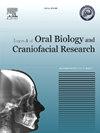血清IL-33和sST2作为癌症生物标志物的临床病理意义:综述
Q1 Medicine
Journal of oral biology and craniofacial research
Pub Date : 2025-04-10
DOI:10.1016/j.jobcr.2025.03.016
引用次数: 0
摘要
背景白细胞介素(IL)-33 及其受体可溶性抑制致瘤性 2(sST2)是免疫反应和癌症生物学中的关键角色。IL-33 可通过促进癌细胞增殖和调节免疫环境来支持肿瘤生长,从而促进肿瘤发生。相反,它也可以通过招募和激活免疫效应细胞来增强抗肿瘤免疫力。本研究旨在评估血清 IL-33 和 sST2 在癌症中的预后意义及其与临床病理特征(CPC)的关联。采用纽卡斯尔-渥太华质量评估量表对研究质量进行了评估。这些研究主要采用观察性和分析性设计,大部分研究在东南亚地区进行,尤其是在中国。在调查癌症血清IL-33水平的研究中,68%(26/38)的研究报告了血清IL-33水平升高,其中大部分集中在肝细胞癌(HCC)和非小细胞肺癌(NSCLC),其次是乳腺癌(BC)和结肠直肠癌(CRC)。此外,85%(22/26)的报告发现血清 IL-33 在癌症和 CPC 中的表达有显著关联。与 IL-33 结合的诱饵受体 sST2 对于调节 IL-33 的可用性和活性至关重要。在对癌症中的 sST2 进行评估的研究中,55%(12/22)的研究显示 sST2 水平升高,其中大多数侧重于 HCC,其次是 BC 和 CRC。此外,54%(7/13)的研究发现 sST2 水平与 CPC 存在显著相关性。同样,在不同的癌症中也观察到了 sST2 水平的升高,这与预后不良有关,进一步凸显了其作为肿瘤进展生物标志物的潜力。IL-33/ST2 信号通路可以在增强免疫反应的同时减轻肿瘤的促进作用,从而提供新的癌症治疗策略。本研究探讨了 IL-33 和 sST2 作为生物标记物的作用、它们在癌症诊断和治疗中的相关性,以及它们与不同癌症类型临床结果的相关性。本文章由计算机程序翻译,如有差异,请以英文原文为准。
The clinicopathological implications of serum IL-33 and sST2 as cancer biomarkers: A narrative review
Background
Interleukin (IL)-33 and its receptor, soluble suppression of tumorigenicity 2 (sST2), are key players in the immune response and cancer biology. IL-33 can promote tumorigenesis by enhancing cancer cell proliferation and modulating the immune environment to support tumor growth. Conversely, it can also bolster anti-tumor immunity by recruiting and activating immune effector cells. IL-33 plays a role in multiple aspects of cancer biology, such as promoting immune evasion, tumor growth, and metastasis.
Objective
This study intends to assess the prognostic significance of serum IL-33 and sST2 in cancer and their association with clinicopathologic characteristics (CPC).
Material & methods
Scopus, PubMed electronic databases and other sources were searched and analysed from 2008–2025. The quality of the study was assessed using the Newcastle-Ottawa Quality Assessment Scale.
Results
A total of forty-four studies meeting the inclusion criteria were analyzed. These studies primarily employed an observational and analytical designs, with the majority conducted in the Southeast Asian region, particularly in China. Among the studies investigating serum IL-33 levels in cancer, 68% (26/38) reported elevated serum IL-33 levels, with the majority focusing on hepatocellular carcinoma (HCC) and non-small cell lung cancer (NSCLC), followed by breast (BC) and colon rectal cancer (CRC). Additionally, 85% (22/26) of the reports found a significant association between serum IL-33 expression in cancer and CPC. For regulating the availability and activity of IL-33, sST2, a decoy receptor that binds to IL-33, is crucial. Of the studies assessing sST2 in cancer, 55% (12/22) showed elevated sST2 levels, with most focusing on HCC, followed by BC and CRC. Furthermore, 54% (7/13) of these studies identified a significant correlation between sST2 levels and CPC.
Conclusion
The detection of increased serum IL-33 across various malignancies highlights its potential as an emerging biomarker for cancer detection and prognosis. Similarly, elevated sST2 levels have been observed in different cancers and are linked to poor prognosis, further highlighting its potential as a biomarker for tumor progression. The IL-33/ST2 signaling pathway could offer new cancer treatment strategies by enhancing immune responses while mitigating tumor-promoting effects. This study explores the roles of IL-33 and sST2 as biomarkers, their relevance in cancer diagnostics and therapeutics, and their correlation with clinical outcomes across different cancer types.
求助全文
通过发布文献求助,成功后即可免费获取论文全文。
去求助
来源期刊

Journal of oral biology and craniofacial research
Medicine-Otorhinolaryngology
CiteScore
4.90
自引率
0.00%
发文量
133
审稿时长
167 days
期刊介绍:
Journal of Oral Biology and Craniofacial Research (JOBCR)is the official journal of the Craniofacial Research Foundation (CRF). The journal aims to provide a common platform for both clinical and translational research and to promote interdisciplinary sciences in craniofacial region. JOBCR publishes content that includes diseases, injuries and defects in the head, neck, face, jaws and the hard and soft tissues of the mouth and jaws and face region; diagnosis and medical management of diseases specific to the orofacial tissues and of oral manifestations of systemic diseases; studies on identifying populations at risk of oral disease or in need of specific care, and comparing regional, environmental, social, and access similarities and differences in dental care between populations; diseases of the mouth and related structures like salivary glands, temporomandibular joints, facial muscles and perioral skin; biomedical engineering, tissue engineering and stem cells. The journal publishes reviews, commentaries, peer-reviewed original research articles, short communication, and case reports.
 求助内容:
求助内容: 应助结果提醒方式:
应助结果提醒方式:


